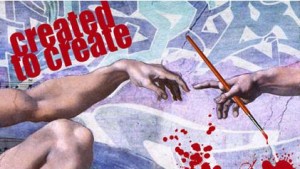 An upcoming conference “Faith and the Arts” merges creativity with the creator along with many probing questions
An upcoming conference “Faith and the Arts” merges creativity with the creator along with many probing questions
By Kelsi Johns,
New Wineskins Ministries, Portland
What Makes Art “Good”? This is a loaded question for the Christian community. The appreciation of art does not rely solely on aesthetic properties, or on how enjoyable the piece may be. The piece tends to be judged, rather than openly experienced, and often becomes a sort of morality litmus test. The upcoming April 25th “Faith and the Arts” conference will explore art and culture in relation to Christ. Is there such a thing as “Christian” art? Since there are so many forms of art, I will explore how, as believers, we tend to view and judge printed art.
I remember last year in a theology class, Dr. Metzger discussed how many people conceive Thomas Kinkade’s paintings as “Christian” art. If Kinkade’s art is taken as a norm for what Christian art should look like, it would seem that for art to be “Christian,” it must evoke pleasant feelings. Think also “Precious Moments,” or the artist Danny Hahlbohm, who paints very peaceful, serene portraits. His “Homecoming” painting depicts a man embraced by a white robed, bearded Jesus. Jesus and this man are in the midst of hazy white clouds with angels and a faint rainbow in the background.
To many, this art can communicate a sort of escapist faith. Yes, Christ is our refuge and our peace, but do paintings that depict only a sort of tranquil utopia do justice to the entire sphere of the Christian life? If I were to paint a depiction of my faith in Christ, it would be angsty, emotional, bloody, hopeful, dark, and sunny all at once. It’s interesting how Christian art has evolved over the years.
Ross Halbach’s article (in this newsletter) explores Rouault’s painting, “Christ Mocked”; this painting suggests more of a darker, controversial Christ. Other paintings around this same time (19th century) tend to depict a very different Christ than the one we see in contemporary art. Why such a change? I would argue that we have stifled our God-given ability to express life in its fullness through art because much of the Christian community tends to be afraid of life’s un-pleasantries. I hold that “Christian” art—if there is such a category—does not necessitate warm and fuzzy art. What are we to make of art that evokes negative feelings: fear, guilt, shame, anger, sadness, longing?
Is such art not of Christ? When “Art” continued from page 1 I see a painting that causes angst or sadness within me, it is in this space that I am reminded of Christ’s redeeming love, his peace and his ability to restore and reconcile even the ugliest of pains or sorrows. This is what leads me to long after this Lord who so gently restores the brokenhearted.
I believe that this is part of why we are created to create: to express and explore the profundity of life in confidence, to marvel at his creation, to communicate from the depths of our soul experiences and realities— even dark and difficult ones— that words cannot touch. And I believe this brings glory to our creator. There is nothing that God avoids addressing and engaging in all of his creation. Thus, in exploring life in its fullness, we discover God on a more profound and exhilerating level.
I will encounter Christ differently after examining Rouault’s paintings than after viewing a Hahlbohm painting. And that’s the beauty of it. We cannot package God to fit one artist’s expression over another. The grand Artist cannot be confined or mastered. This is what inspires me to marvel and explore even more this world that God has so intentionally created for us to enjoy, re-imagine and re-create.
God calls us as his handiwork to bear witness to his creative designs through our own creative expressions. It is an honor to be able to artistically reflect upon God’s involvement in the world which he has designed and which he redeems from decay and despair—from the inside out.
Disclaimer: Articles featured on Oregon Report are the creation, responsibility and opinion of the authoring individual or organization which is featured at the top of every article.


